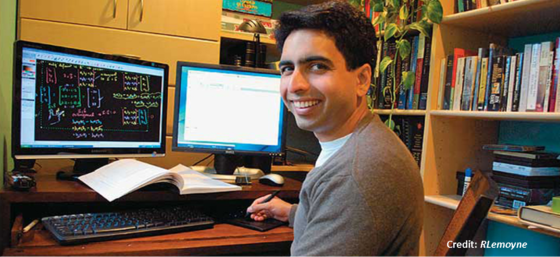
Khan Academy Arrives in Latin America
The Khan Academy, challenges the traditional teaching model with its instructional online videos and learn-as-you-go problem sets.
This post is also available in: Spanish
In early March, Latin America was forced to close public spaces due to the Covid-19 pandemic. Most countries shut down borders and asked their inhabitants to work from home, prompting a wave of remote work. Additionally, schools had to close their doors and begin the transition to distance learning. This situation revealed greater connectivity deficiencies than expected in many countries in the region. The challenge of staying connected during a pandemic disproportionately affects populations with limited financial resources and those in remote areas.
Since then, there has been a great effort by both the public and private sectors to alleviate the obstacles presented by distance learning and remote work. Telecommunications companies have played a key role in expanding access to connectivity and digital educational resources. New initiatives to address these challenges have been implemented throughout Latin America. Some telephone companies have improved the quality of their services at no additional cost to their customers and others have formed partnerships with the region’s ministries of education to launch platforms that do not require a stable internet connection. Below, we present some of the responses implemented by telecommunication companies in the region to address connectivity problems in order to support all household needs whether they be educational or work-related.
Several telecommunications companies have strategically adapted their services to reduce costs or offer access to educational resources. Many, including Claro, Movistar, AT&T, DirecTV, Tigo y Antel, have sought to adapt their services to the needs generated by the crisis. In Colombia, both the public and private sectors have continually strived to provide a network of educational services that are accessible even to students with limited resources. In this particular case, certain educational platforms such as Colombia Aprende can be accessed without internet connection. Alongside these efforts, at the outset of the pandemic, Claro foresaw a spike in the use of its services that in turn would slow down connectivity. Therefore, the company announced that its prepaid and postpaid customers would have access to more data and minutes in all available packages automatically and for free. Although these services were only proposed for a limited time, as the pandemic continues to develop, they have continued to remain in place. For example, with respect to home services, Claro has increased the speed of internet connection by 50 percent to facilitate work and academic activities.
Today, Claro continues to offer high-speed services thanks to its investments in higher frequency bands such as the 2.5 GHz band, to increase the speed and downloadability of its mobile internet at no additional cost. Strengthening telecommunications and connectivity services has been crucial in enabling different users to participate in simultaneous video calls from the same home, particularly in the case of caregivers who must telework while their children attend online classes.
Another company that has stood out for its services during the pandemic is Movistar. In Chile, the company increased fiber-optic speed and home services up to 100 percent, reducing consumption restrictions to support telework and school work dynamics. Movistar also changed their data policy on social networks like Whatsapp and Twitter, so that students and teachers who do not have access to alternative communication platforms can interact without depleting their mobile data plan. This is extremely beneficial since recent surveys show that teachers in the region use social media networks like WhatsApp as a primary means of communication with their students. Many governments in the region also use WhatsApp to distribute educational guides and resources to teachers.
While many companies are focusing their efforts on increasing coverage or broad band speed, other companies like Movistar, A&T, DirecTV, and Tigo have expanded their educational services as well. Movistar has launched free learning platforms such as STEMbyme, ProFuturo, and #ConectaEmpleo. AT&T has offered access to the platform Escuela Plus alongside DirecTV which also has expanded their educational channel selections for cable plans that originally did not have access to Disney, National Geographic, Discovery, Torneos y Takeoff Media. DirecTV’s initiative has been implemented in Argentina, Chile, Colombia, Ecuador, Peru y Uruguay. In addition, the company Tigo has focused its efforts on training teachers on the use of Information and Communications Technology (ICTs) so that they can better utilize the platforms available to them through the initiative Conéctate Segur@.
In Uruguay where there was already a high connectivity rate, the state-owned company Antel developed a massive outreach strategy to respond to the needs during the pandemic. The company first gave away a five-gigabyte bonus at the beginning of the shutdown so that people could “access the distance learning programs that are being implemented.” Its various initiatives include the Plan Universal Hogares and the Ibirapitá Plan with 50 gigabytes each. Antel also has gone a step further and is providing 40 gigabytes per month free of charge during the months of May, June, and July to all teachers affiliated with the ANEP teacher plan in order to support the development of teleducation. Apart from ensuring that Uruguayans are connected to the internet, Antel, along with the Bank of the Eastern Republic of Uruguay (BROU), facilitated the delivery of emergency food baskets through their mobile application. In the first week of operation, more than 30,000 beneficiaries were able to receive food and other critical resources from the Ministry of Social Development. Thanks to the collaboration between Antel and the Ministry of Social Development, it was possible to manage these services completely remotely.
Collaborations between ministries and telephone companies have been crucial to closing the connectivity gap during the pandemic. Like the collaboration between Antel and the Ministry of Social Development, telecommunications companies across the region have expanded their work to facilitate the services governments want to provide. In Argentina, for example, the Ministry of Education, along with the president of the National Communications Agency (ENACOM), announced that the three mobile phone companies Movistar, Claro and Personal will allow free access to the educational platforms and virtual classrooms at more than 57 national universities. This agreement allows for the democratization of access to resources and classes that in-person students have previously not had access to at home. In addition to releasing data from these websites, the distance learning platform, Seguimos Educando, was launched to access a free collection of virtual educational materials and resources organized by subject and grade.
The Chilean platform AprendoEnLínea, which provides educational resources for all grades, offers free access thanks to mobile phone companies, Entel, Claro, GTD, Movistar, and VTR, grouped into the Mobile Telephone Association (ATELMO). Similarly in the Dominican Republic, Claro signed an agreement with the Ministry of Higher Education, Science and Technology (MESCYT), the Dominican Association of Universities (ADOU) and the Dominican Association of University Rectors (ADRU) to offer fixed and mobile internet plans at special prices to more than 600,000 students and 30,000 teachers from 51 universities. This initiative accompanies efforts already in place in the Dominican Republic, where there are more than 1,000 free WiFi hotspots distributed throughout the country.
Public and private sector joint initiatives in Latin America demonstrate the importance and impact of collaborations between the two sectors to achieve quality virtual education. Technology can be a transformative tool that expands the opportunities for all children in the region, but only if it is accompanied by universal access to electricity and the internet. Many of the measures implemented to confront this crisis are temporary, but it is important that telecommunications companies continue to provide additional supportive services until educational establishments reopen in person; otherwise, continuity of education will be impaired. As connectivity remains a limiting factor for vulnerable students, governments and businesses have a duty to work collaboratively to remove this barrier. A family should not have to choose between prioritizing their children’s online education and teleworking. Just like a teacher should be able to access the resources they need to teach without having to pay a burdensome fee. The pandemic has accelerated innovation in online education, but to further promote the progress of these tools in the future it is imperative to enhance public-private partnerships to close the connectivity gap.
Covid-19 in the Americas: The Dialogue’s Coronavirus Updates
How to protect education outcomes in the face of the Covid-19 crisis?
What About the Students?: The Educational Response to Covid-19
Covid-19 in the Americas: The Dialogue’s Coronavirus Updates
How to protect education outcomes in the face of the Covid-19 crisis?
What About the Students?: The Educational Response to Covid-19
The Khan Academy, challenges the traditional teaching model with its instructional online videos and learn-as-you-go problem sets.
Online competency-based education is attempting to create a sea change in education, largely for underserved or unserved populations of students.
